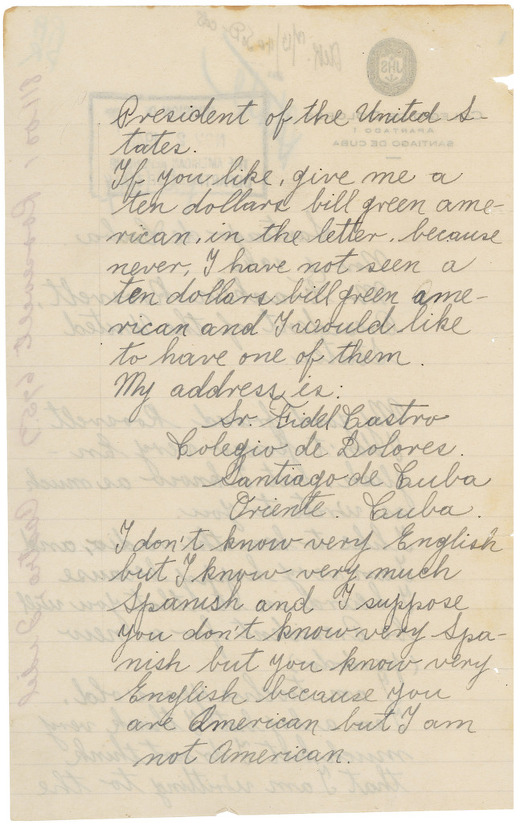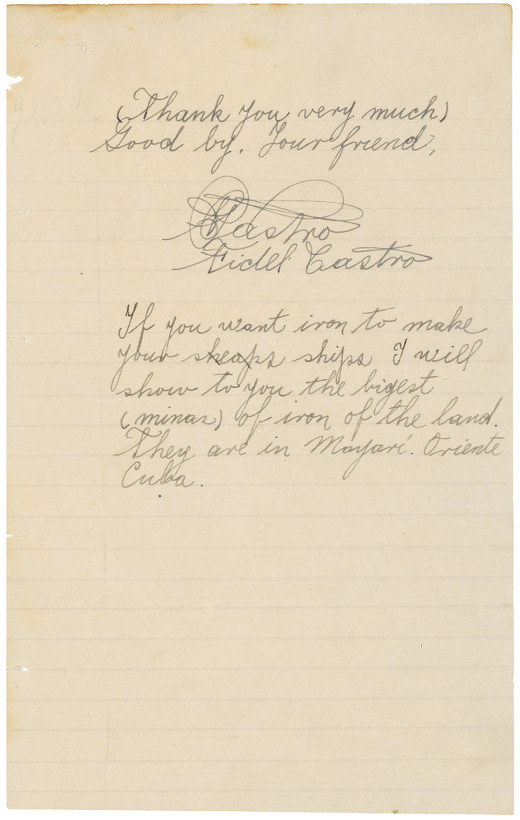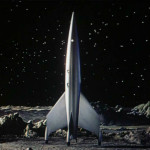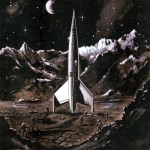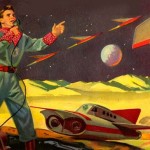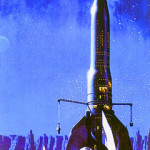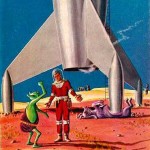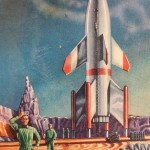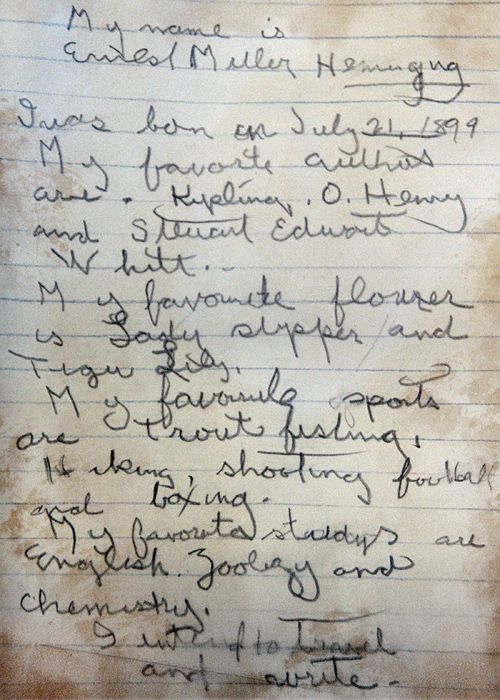A most interesting and unusual man was lost on February 10, 2012. I had the pleasure of meeting Jerry Brown through our mutual passion for astronomy, and considered him a grandfatherly friend.
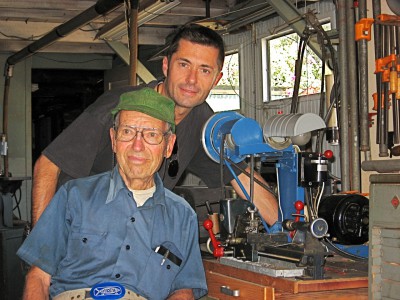
Here I am visiting Jerry Brown (left) in his workshop in 2009. The machine to the right is one of many he built. Reinhard Kargl, 2009. Click to enlarge.
Jerry was a quiet and introverted man who preferred the solitude of his home and workshop to the hustle and bustle of the world. His demeanor was somewhat eccentric (which is precisely why I became interested in him), but Jerry’s humble, unassuming ways did not advertise the genius he really was.
After his parents passed away, Jerry continued to live in his boyhood home in Culver City, California. He himself suspected that he might have “a mild case of autism”, to which he attributed his lack of desire to be more social, marry or have a family. He lived frugally and all by himself until the end, and he liked his usual routines so much that he viewed any change with suspicion, and as a possible nuisance. He said he was afraid of dying, but even more so, of languishing in a debilitated state.
After a stint in the Army, during which he was trained as a radar technician (and which, as far as I know, was the only time he really travelled over a great distance) Jerry held mechanical jobs in the Californian aerospace industry and at a model shop.
But the things Jerry was really interested in were happening in his free time — in the evenings and during weekends. Having had an enormous fascination with machines since childhood, Jerry had started to construct his own.
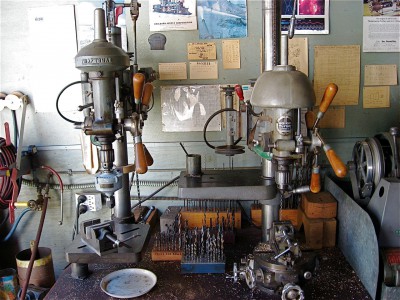
A corner of Jerry Brown's workshop, which seemed like a place from another time. Photo: Reinhard Kargl, 2009.
In the process, despite lacking an advanced technical education, Jerry taught himself drafting and engineering and acquired a broad variety of mechanical and metalworking skills. Being particularly interested in steam engines, Jerry designed and built his own — entirely from scratch. His workshop contained a metal foundry, all sorts of metal working machines (many of which he constructed himself, because he could not afford to buy them). For his steam engines, he manufactured gears, boilers, pistons and most other parts all by himself.
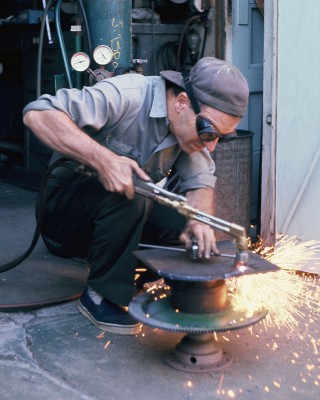
Jerry Brown in the 1970s. Photographer unknown.
In his own essay, “The Making of a Model Engineer”, Jerry wrote:
“After acquiring a standard lathe and milling machine I was ready for a serious project. My goal was to build, from scratch, an engine big enough to do useful work. Perusing old steam engineering books, I was able to design what I wanted—a 1.25″ bore x 2.25” stroke engine similar to those that powered mills and factories in the 19th and early 20th centuries. I made wood patterns to form sand molds, and poured metal castings for the major parts. After everything was assembled I tried a test run on compressed air. No problems, so next was a steam test (with borrowed steam at a club meet, since I had no boiler.) It ran fine, with no leaks, which an onlooker said was rare for a first-run on steam. I subsequently had a boiler built, and mounted it with the engine on skids for portability. After some 40 years it’s still running as well as ever, powering a grain mill which grinds corn for my pancakes. Fired with scrap wood (or corn cobs) it’s a big attraction at antique engine shows.
Despite these accomplishments, I still hadn’t fulfilled my childhood dream of building a steam-powered miniature revolving crane/excavator. These were all gone from the construction world in my time, except for some that survived into the 1970s as pile drivers because their boilers could supply steam for the hammer. I always liked watching these things. If I were a musician I’d have to be a percussionist because, like the legendary John Henry, I love to hear that cold steel ring. In 1972, working for a company that made live-steam miniature railroad equipment, I figured the time had come and I’d best not wait any longer. The crane would be a vastly more complicated project than a plain stationary engine, but I plunged in, learning as I went. It was a labor of love, culminating in1978 with the first steam-up. Thirty years later it’s still going strong, digging in my garden and demonstrating at shows what steam power once did (like building the Panama Canal.)”
It took many years, but eventually Jerry was successful. Here he is with his masterpiece:
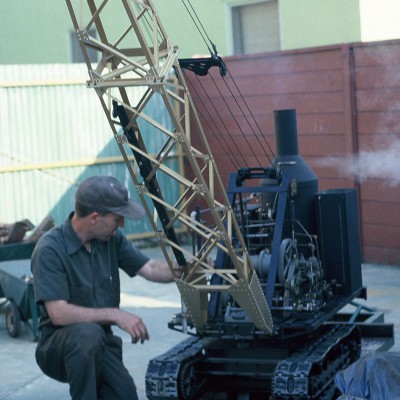
Jerry Brown and his steam powered shovel, some time in the 1970s. Photographer unknown. (Click to enlarge).
Jerry’s other great interest in life was science, especially astronomy.
“Physics is said to be the basic science; I think astronomy/cosmology is a close second. I like the way Stephen Hawking put it when asked of what use was his work: It won’t make your wash any whiter, but we need to know what we are and where we came from. It’s rewarding be associated with people having a common interest in these subjects.
I think my interest in astronomy began around 1940 when I read a science column in the old original Los Angeles Daily News (I guess that pretty well dates me.) It mentioned some stars being so dense that a spoonful of their material would weigh tones here on Earth. At age 10, that was mind-boggling. (It still is.) I went on a 7th grade field trip to the Griffith Observatory, and still remember my “first contact” with the Foucault Pendulum. Also, the electromagnetic spectrum chart showing the narrow band we know as visible light. In high school I built my first telescope using lenses that came with a science book I’d bought. They weren’t color-corrected, so you can imagine the images I got. But it was enough to tell me there was a lot out there I wanted to know about.
In the Amy (1950) I read Fred Hoyle’s book describing his steady-state theory. That kept my interest alive. In the middle 60s, thanks largely to a neighbor who was interested in astronomy, I built a better telescope (which is still in use.) Together we built a 3″ reflector from scratch. Around 1990 a sort of philosophical crisis motivated me to renew my too-long dormant interest in science. It has been the most intellectually rewarding experience of my life. I think that I have finally, to use Timothy Ferris’s phrase, come of age in the Milky Way. Took a long time, but better late than never.”
(J.B., via e-mail, 2011-11-11).
In addition to working on his machines, Jerry was active with the Santa Monica Amateur Astronomy Club, and the Los Angeles Live Steamers Railroad Museum. He was also a member of FOTO (the Friends of the Griffith Observatory), the Southern California Home Shop Machinists, and the Center for Inquiry. He also has a keen interest in pipe theater organs and attended shows whenever he could.
Jerry was not a religious man. Indeed, he viewed “organized religion” with a measure of disdain. On the other hand, he was a compassionate humanist who had respect for all living things, to the point of becoming a vegetarian. I would say that the Golden Rule, and a desire to do no harm were the most important maxims in his life.
His steam shovel, the crowning achievement of Jerry’s life, has continued to be an attraction at shows and events for several decades now, and Jerry enjoyed operating and exhibiting it in public. He even made the fuel (most currently a biodiesel he made from spent restaurant cooking oil).
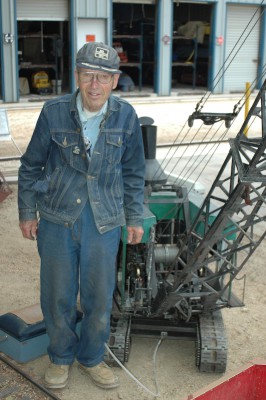
Jerry Bown and his steam shovel at the Spring 2009 meeting of the Los Angeles Live Steamers Railroad Museum. Photo: Matthew Swain. Click to enlarge.
The last few weeks had been unkind to Jerry’s health. His heart and cardiovascular system had already been weakened over the last few years, and now, he was becoming dehydrated and exhausted from a lack of sleep, which he attributed to a “stomach flu”. But he seemed to be getting better.
I was expecting to see Jerry on Friday, Feb. 10, at a meeting and science lecture in the evening. But the day before, Jerry e-mailed:
“Much as I hate to, I’ll very likely have to miss it. Whatever hit me last month has returned with a vengeance, this time with hiccups like 2 years ago which will preclude sleep tonight.”
Little did I suspect that it was to be his last message. Jerry was taken to the hospital on Friday morning and passed away later that day.
Attending astronomy lectures without him will be sad. He had been a fixture for so many years. My only consolation is that Jerry’s very worst fear did not come true: he did not have to languish in a semi-vegetative state.
Jerry had no family. As of this time, no funeral arrangements have been publicized. I will make updates here as soon as details come to my knowledge.
The story of Jerry’s masterpiece is recounted in detail, and with many pictures, on this page:
http://craftsmanshipmuseum.com/JBrown.htm
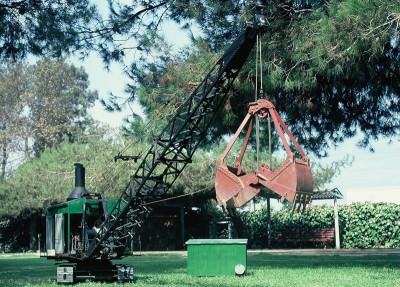
Although Jerry is gone, his masterpiece will remain. Photographer unknown. Click to enlarge.
It is only fitting that Jerry should have the last word:
“Why did I build it? Why does one swim the Channel or build a Brooklyn Bridge from toothpicks? In this case, as I say, it was a lifetime ambition. I’ve always liked to watch the wheels go ‘round, especially when they’re steam powered. And maybe because this machinery is kind of a reminder of a time long-gone when some of our present problems hadn’t even been thought of. In any event, I’m glad I did it when I did. One thing I’ve learned is that if you want to do something, do it as soon as you can because you never know when it will be too late. Watching the clam pull itself into the ground as the closing line snakes through all those sheaves to the sound of the engine and smell of steam and hot oil made it all worthwhile. Not to mention the amazement of spectators, most of whom never saw the big ones at work. And the small boy, growing up in the plastic, throw-away age asking sort of awe-struck, “Is that made out of metal?” Steam machinery buffs will understand.”
(From: A Miniature Live Steam Crane, by Jerry Brown. Australian Model Engineering magazine, March/April 2008).






